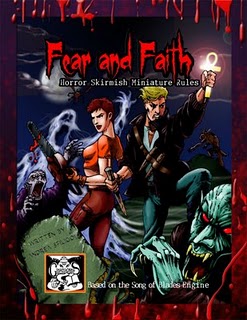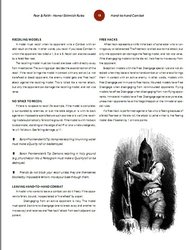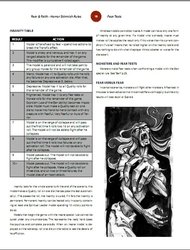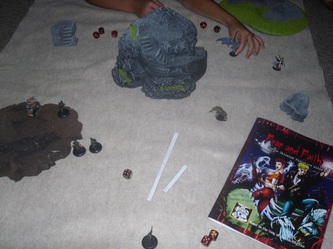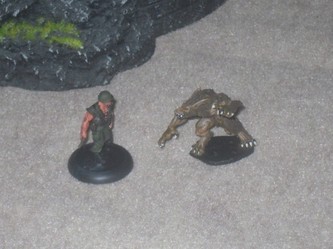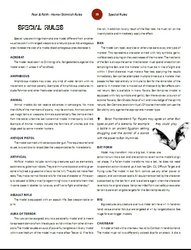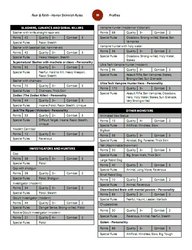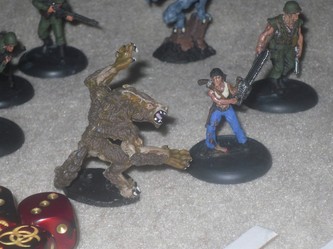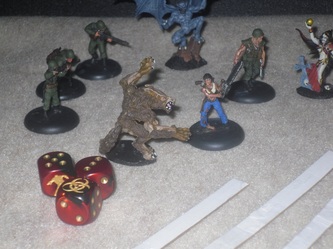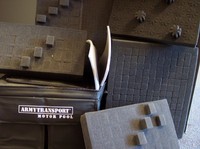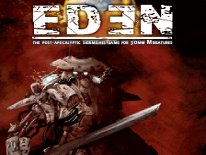|
July 7th, 2010
In Focus Review - Fear and Faith Fear and Faith is Ganesha Games horror genre skirmish miniatures game, which is also based on the Song of Blades and Heroes (SoBaH) game engine. In Fear and Faith you can setup games in Victorian/Gothic horror settings, modern day psycho slasher film settings, and everything in between. Instead of rehashing everything I've already said twice already in the previous two Ganesha Game reviews of Song of Blades and Heroes, and Mutants and Death Ray Guns... I'd suggest reading either of those two reviews over for the basics of the game mechanics that you'll find in Fear and Faith. Combat and rolling for activation is pretty much identical. Like all of the SoBaH games I've seen so far, Fear and Faith also utilizes 3X D6 dice, and three measuring sticks at three specific lengths, instead of a measuring tape. The length of the sticks is determined by what scale you decide to utilize, because the game supports both 15mm and 25-28mm scale models. You also use what ever miniatures you want to play the game with, so there's no hefty initial model investment to deal with. The play area for 15mm games is 2x2 ft, and 25-28mm scale calls for 3X3 ft. There's really only two stats for each model of major importance too, (just like any of the SoBaH games), these are the Quality and Combat Stats. The Quality stat is used to roll against for how many Actions/Activations per turn each model is given (used in Morale/Fear tests as well), and the Combat stat is used for Ranged and Hand 2 Hand combat. Aside from that each model has a point cost, and lastly Special Rules are your abilities, which truly define the characters. That's as in-depth as a character is defined via stats in Fear and Faith. What's new over Song of Blades and Heroes, and Mutants and Death Ray Guns...
Fear and Faith brings Determining Time into the game, and this has an effect on how certain creatures behave. On a roll of 1-3 the scenario will take place at Twilight, and on a result of 4-6 the scenario begins at Dawn. There's a Good player and an Evil player also, which is determined beforehand of course, and if the Good player rolls two turnovers, then night falls and the scenario is considered to take place at night now. This is bad for the Good player, depending on what he/she is facing. When the Evil player rolls two turnovers, Dawn will break and it becomes Daytime. This is good for the Good player, again, depending on what they're facing. Turnovers occur when a player rolling for actions fails two times during a single activation roll, and the turn is then passed to the other player. Vampires for instance are at a disadvantage of -1 on their Quality rolls for activations, and can be killed by normal weapons during the Day. If you end up with a Night scenario, you are to roll a D6, and on a result of 5-6 there is now a full moon, during which werewolves gain a +1 on their Quality rolls in their first turn of the game. If the scenario you decide to play takes place outdoors, you can also roll for Weather conditions. A roll of 5-6 determines if any special weather conditions will exist. If a 5-6 was rolled, now you roll again for the special condition. On a roll of 1-4 it rains (-1 to all ranged attacks), on a result of 5 there's fog (limits LOS to Short range) and on roll of 6 there's a storm (-1 to all ranged attacks AND Short range LOS). The game itself is also more scenario based than the other previous Ganesha Games I've reviewed. You can easily play straight up death-match type scenarios in Fear and Faith, but this doesn't make for the most fun game experience when the sides aren't balanced properly beforehand. You really need to think out, and agree upon the Good and Evil group compositions ahead of time, because there isn't a single “best army” to take to the field, and some combos just won't work against others very well. For instance, Vampire hunters equipped for Vampire hunting wouldn't be very effective against Werewolves. Therefore playing the scenarios using what they suggest, or building the right groups to make up each side is important for optimal fun. Mobs are also present in Fear and Faith. Zombies, Cultists and Villagers can use the Group Action Mob rule, which grant a mob a free move every turn before activation towards their enemy.
So this could be a zombie survival game if you wanted it to be, or you can play out a scenario where an angry mob of pitchfork, and axe wielding villagers chase down a flesh-golem, and the evil mad scientist who created it. There is a profile for Baron Frankenstein, Frankenstein's Monster, his Hunchback assistant, the Bride, even a failed experiment creature, and grave diggers who harvest parts from the dead. With what's provided you could easily play out an entire Frankenstein, Bride of Frankenstein, Son of Frankenstein, and Frankenstein Meets the Wolfman campaign with Fear and Faith if you wanted to. Weapons, Gear and Special Abilities is also what really sets this game apart from the other previously covered Ganesha Games. Bow, Crossbow, Antique Pistol, Musket, Single Chambered Rifle, Bolt action rifle, Semi-auto rifle, Assault Rifle, Pistol, Machine Pistol, Sub Machine gun, Shotgun, Thrown Weapon, Grenade, Sun Grenade, and Holy Water Vial detail all of the ranged weapons included. There's also a way to cross reference the list, detailing which of those ranged weapons can utilize Silver bullets or Silver pellets, and which can utilize projectiles made of wood for maximum Vampire and Werewolf killing power.. Like Mutants and Death Ray Guns, all models in Fear and Faith are considered to have a generic Hand-2-Hand weapon. There's only a small handful of Hand-2-Hand weapons mentioned otherwise, most of which are Special Rules like the Chainsaw, and the Machete/Claws. These are found included within the existing character profiles only. Hand-2-Hand combat is a big part of the combat in Fear and Faith, since that's really the only way Werewolves and other creatures engage in combat, but there are far more ranged weapons in the game, than there are melee ones. Although I must admit, the melee weapons included, are rather cool. I just wish there were more of them. There's also roughly 8 pages worth of pre-made profiles you can use towards the back of the book. These cover so much ground too. One whole page details Zombie Hunter/Survivors and Zombies, another page covers Werewolves and Frankenstein characters. Another page covers nothing but Transylvanian Villagers and Victorian Hunters, the opposite page Slashers, Lunatics and Serial Killers, Investigators/Modern Hunters and Other Monsters. Other Monsters include Bigfoot, Animated wax statues, rabid dogs, and Chupacabras just to name a few. Occult Investigators, Ghosts, and Spirits & Demons take up a page and a half of profiles, and an entire half page worth of Vampires and Vampire Minions are also provided. Things from Beyond features Creatures from Beyond, Avatar of a Mindless Space God, pretty much the sci-fi-like creatures. Lastly Mummies and Swarms make up the rest of the final page, allowing you to recreate classic swarm movies like Food of the Gods, or Piranha if you so choose. Fear and Faith also introduces the Fear test, to represent a players fear of a gruesome creature, or horrific event. There are various negative and advantageous modifiers both to be factored into the roll as well. The roll itself is the same as a Quality roll for activation with three D6, only with different modifiers. If on holy ground you gain a +2, if the model has the Strong Willed special rule, you also gain a +2, but if the monster charging you is Very Fearful you start off with a -2, and if the test is being caused by having witnessed a Gruesome Death you start off with a -1, just to name a few of the modifiers. If you fail a Fear test with one of the three D6 you may end up being forced to Recoil, which is when you must move one base-width directly away from the foe. If you end up with a result of Scared by failing 2 of the 3 dice, you roll again on the Scared table and can end up simply recoiling, Transfixed by Fear, or you could even trip and fall as you recoil, just to name a few of the possible outcomes. Fail all three D6 rolls of a Fear test, and you could also end up Insane, and then rolling for a result on the Insanity table. The results on the Insanity table are quite severe, and the results of Insanity last the rest of the entire scenario. On a result of a 2, the Model is shaky and nervous, and has a -1 on any ranged attacks for the remainder of the game. On a result of an 8 the model is on the verge of collapse, and will pass out the first time it rolls two failures on any activation roll. There's ten different possible results on the table to reference, based on what you roll (1-10+) Although a character with the Hero special rule automatically passes one of the three D6 Fear rolls. The insanity also comes into play throughout Campaign play too, because Insanity can be cured at the end of a Scenario, but if you fail the single roll to cure it, or don't have 10 campaign points to spend to cure it, that model may end up still Insane throughout the next scenario/game as well. Like Song of Blades and Heroes, there's magic users in Fear and Faith as well, and the same rolling for spell activation, taking the place of your regular activation rolls is in place here too. Magic is pretty limited though, as there's only a few spells to choose from. Human Sacrifice allows a witch to kill a friendly living model, and based on their point value gains a +1 or +2 on Quality rolls next turn. It's nice that Witchcraft was included since it's a horror game, but it seems more of a carry over from the original games, than something truly useful in Fear and Faith.
Transfix is a pain in the butt tho, but again, that's really the only major threat I see a witch possessing. You could end up Cursed too from a Witch, and that changes your Quality stat by one digit to a worse number. However a model with the Spiritual Leader special rule can break Curses too. You also run the risk of not being able to perform any spells for the rest of the game, if you ever fail all 3 of your spell activation rolls. The Special Rules, which I consider the special abilities, is what really define the characters beyond the point cost, and Quality and Combat stat each model features. Clinging for instance allows a model to cling to all surfaces, walking on walls, ceilings, etc, doesn't take damage from normal falls, and is considering at a higher elevation when attacking gaining a +1 in Hand-2-Hand combat. Demonologist is considered a magic user, but it's the one that I feel is the most useful. They can allocate a number of their points for creating their force to a Summoning Pool to use later. If they wanted to toss 50 points into the pool, what ever amount they throw in is doubled, therefore that 50 becomes 100 points. During the game they can then attempt to Summon a creature, the same way you roll for spell activation. A single passing result grants summoning a demon of 35 points or less, 2 passing results and they can summon a creature with a maximum point value of 100 points, and 3 passing results and any demon on the list is available for summoning. The catch is, they must have enough points in the Summoning Pool to call the demon. Of course the Holy Water rule effects vampires and demons only, but is quite effective at killing them. Immaterial models are tricky too, one with the Immaterial rule can't be phased by physical combat, only magic weapons, spells, or another immaterial model can harm them. Vampires can also be effected by explosives, silver and regular weapons, but the most those will do is result in a knockdown. To kill them you must use spells, holy water, a sun grenade, a wooden stake, or via the use of fire when they're in their human form. Werewolves are similar, they can only be killed by fire, silver weapons or spells. Wolf Form is another unique rule, one that both Vampires and Werewolves can utilize, allowing them to spend one action to transform into a large wolf, and it's a free action to return to what ever their original form was to begin with. That only covers a small number of the Special Rules, as there's roughly 65 Special Rules listed in the book. The scenarios provided are also rather nice. Six scenarios are provided... Zombie Infestation (400 points of zombies vs 300 points of hunters), Vampire Hunt (300 point vampire/minions vs 300 points of vampire Hunters), The Chainsaw Massacre or These Hamburgers Taste Funny (civilians/police/agents vs slasher/lunatics in a survival scenario), Haunted House (300 points Ghosts vs Ghost Hunters), Human Cattle (400 point vampires vs 400 points werewolves attempting to steal each others food) and lastly Wolves in the Midst (300 points werewolves vs 300 points of werewolf hunters). It's really not hard to create your own either, but the ones provided are quite fun, and they also make a good template for creating new scenarios from. The Campaign play is also pretty-much the same as you'll find in Mutants and Death Ray Guns (minus the Upkeep mechanic), only the Advances offered are more tuned for the horror-genre. Victory points are also earned and spent in the same manner. Although Infectious Curse is a new campaign rule, and at the end of a scenario, before moving on to the next, if a model was knocked down by a zombie, werewolf, vampire or mummy, you need to roll to see if they were infected. If so they can be cured for 10 VP through a Spiritual Leader, or end up being a Minor Zombie, Vampire, Werewolf, etc. If you like the progression of a campaign setting, it really doesn't get much easier than this. With each new Ganesha Games release the rulebook layout, and design keeps getting better too. The rulebook is 48-pages, and throughout the book at the bottom of various paragraphs you'll find “Baron Frankenstein's Tip”, which begins to explain more in detail about a rule, or mechanic, which makes learning the game that much easier than previous products too. While this is a black and white affair, they still did a good job of presentation as well. This is the best Ganesha rulebook I've seen yet, and the previous ones weren't bad to begin with. Conclusion
This is by far my favorite game from Ganesha Games yet! It's as simple to pickup and play as Song of Blades and Heroes, with just a few more rules, only rooted in a horror setting. Dracula, Frankenstein, Werewolves, Jack the Ripper, the Zodiac Killer, and Abraham Van Helsing templates are provided covering many of the classic horror characters, and there's even a profile for a Super-Natural Slasher with Machete/Claws if you want to play out a Jason, Freddy or a Michael Meyers game even. Fear and Faith even makes a great zombie survival game, due to its simplicity. It's clear that the designer has a sense of humor too, because there are profiles for a Zombie Elephant, Zombie Horse and Animated Severed Hand. You could even use Fear and Faith to engage in Cthulhu/1920s pulp scenarios. I thought it would be fun to find some miniatures that look like Abbott and Costello, and play out Abbott and Costello Meet The Mummy, Meet Frankenstein, and so on, because with Fear and Faith I can. I think what makes the game so great is, that it's not just a zombie game, it's not just a vampire game, it's not just a slasher or pulp horror game, instead it's which ever horror genre skirmish game you want it to be. Fear and Faith is more than anything else, the ultimate toolkit for playing a horror genre skirmish miniatures game. So you say you can't find a character you want to play in the back of the book from the 130+ profiles provided? No problem, there's an online Party Builder available to use as well. I used it to create a custom Sgt Rock WWII character, some supporting WWII soldiers, and a chainsaw toting survivor chick to play versus a Werewolf, Gargoyle and Vampire. It's that simple. Since Fear and Faith utilizes which ever models you have on hand, there's next to no investment outside of the cost of the rulebook either. Even if you don't have any horror models, these days Horror Clix are so cheap that one could easily spend $20 on 8-10 boosters and end up with more models than you'd ever need to play Fear and Faith with. I had fun using a plastic pre-painted Werewolf, Vampire and Gargoyle from Reaper's Asylum line, and some metal Reich of the Dead US soldier models, also from Reaper to play the game with. Actually Reaper has a variety of simply amazing horror models that would be ideal for Fear and Faith, most of which cost $3-$6 max each. What's more, the PDF version of Fear and Faith is just $8, and the printed version which I reviewed is available from Lulu.com for just $15.99. Fear and Faith is definitely not a game that's going suck your wallet dry to play it. Since it's so similar to the other Ganesha Games products, utilizing the same core combat mechanics, it wouldn't be tough at all to mix and match Mutants and Death Ray Guns with Fear and Faith, or even Song of Blades and Heroes with Fear and Faith with very little modification. If you're looking for a horror skirmish game that's flexible, inexpensive, and most importantly loads of fun, Fear and Faith is totally that game, and more. At present Ganesha Games is working on three expansions for Fear and Faith. The tongue in cheek Kooky Teenage Monster Hunters is the one I'm looking most forward to seeing when it's done. That's clearly a take on Scooby Doo. The other project is a more zombie oriented expansion called Fear and Flesh, and lastly GhostRangers sounds a lot like a take on Ghost Busters. |
|

|
|
- Home
-
Reviews
- Interview - Matt Wagner/Eagle Dynamics
- Interview - Polychop Simulations
- Review - MonsterTech HOTAS Table Mounts
- Review - Rebel Galaxy Outlaw
- Review - EVGA 2080 Super Black Gaming 8GB Video Card
- Review - ASUS VG49VQ 49 Inch Super Ultra Wide Gaming Monitor
- In Focus Review - Heatblur's F-14 Tomcat Module for DCS World
- Classic Review - Jetfighter III
- Review - Thrustmaster T.Flight Rudder Pedals
- Review - Thrustmaster HOTAS WARTHOG Joystick
- First Impressions - DCS World High Fidelity Modules
- Classic Review - Suncom Strike Fighter Series Throttle
- Classic Review - F-22 Pro Joystick from Thrustmaster
- Classic Review - EuroFighter 2000
- In Focus Review - DCS World Persian Gulf Map Module
- Classic Review - US NAVY Fighters
- Review -TrackIR 5 from NaturalPoint
- Review - Thrustmaster T16000M FCS HOTAS
- Classic Review - Jane's AH-64D Longbow
- In Focus Review - DCS World Revisited: Diving off the Flaming Cliffs
- In Focus Review - State of Flight-Sims and HOTAS Games 2019
- Review - Flamberge/Jumping Atlas/WASP WSP-1 Models from Iron Wind Metals
- Review - Star Trek Starships Collection
- Review - Knight Models Arkham City Bane 35mm Model
- Review - Knight Models Man of Steel & Frank Miller Batman 35mm Models
- Review - Mecha Zone 2: The Art of David A White
- In Focus Review - SuperSystem 3rd Edition
- In Focus Review - Heavy Gear: Arena Two-Player Starter Set
- Review - JUNK: Dogface Combots from Grindhouse Games
- In Focus Review - ShadowSea from AntiMatter Games
- Review - TRO 3085 Lance Pack
- Review - Technical Read Out 3085 & Record Sheets 3085
- In Focus Review - JR Miniatures 25mm Medieval Structures
- In Focus Review - Dust Tactics
- In Focus Review - War Rocket
- In Focus Review/Interview - Plasma Blast Games 6mm Sci-Fi Models
- Review - PortableWarfare Sergeant Case
- Review - Steel Warriors
- Review - Having Good Hex: Hex Bases 101
- Review - Xmarx & Old Crow 6mm Sci-Fi Models
- Review - BattleTech Mech Models
- In Focus Review - BattleTech
- Review - Song Of Our Ancestors
- In Focus Review - BattleTech Total Warfare Core Rulebook
- Review -Rosemary & Co Brushes
- Review - Q-Workshop Pirate & Sniper Dice
- Review - HiTech Miniatures SF Commander & 25mm Resin Bases
- Review - Tengu Models
- Review - Atomic Super Humans
- In Focus Review - Warlord 2nd Edition/Savage North
- Review - The Complete Guide to Miniature Painting
- Review - JR Miniatures 15mm Scale Terrain
- Review - HellDorado LOST Starter Set Review
- Review - Heavy Gear: Black Talon Return to Cat's Eye
- Review - Mantic Games Dwarfs Iron Belcher Cannon Review
- Review - Heavy Infantry/Kolony Feral HQ Models
- Review - HellDorado Westerners Starter Set
- In Focus Review - Heavy Gear Interpolar War 2-Player Starter Set
- Review - Micro-Art Studio Hive/Power Plant and Ruins Bases
- Review - Wargames Factory Shock Troops Models
- Review - Mantic Games Dwarfs IronClad Regiment
- Review - Mantic Games Dwarfs Ironwatch Troop
- Review - MERCS Minis FCC Models
- In Focus Review - Incursion board game from Grindhouse Games
- Review - Incursion Models from Grindhouse Games
- Review - MERCS Minis USCR Models
- In Focus Review - AE Bounty from Darkson Designs
- Review - AE Bounty Starter Set Models
- Review - Micro-Art Studio Great Wolves
- Review - Kabuki Models Revisited
- In Focus Review - Eden Post Apocalyptic Skirmish Game
- Review - Soda Pop Miniatures Models
- In Focus Review - Warpaints Wargaming Starter Paints Set
- Review - Freebooter's Fate: Crew Expansion Models
- In Focus Review - Quantum Gothic Part III
- Review - Ron & Bones Undead/Skeleton Models
- Review - Zynvaded Starter Set
- In Focus Review/Interview - Reaper Miniatures, Inc
- Review - Armory Primer
- Review - Pulp City Models
- In Focus Review - Bob Smith Industries CA Adhesives
- In Focus Review - Derivan MiNiS Paints
- In Focus Review - MaxMini Models & Bitz
- In Focus Review - Studio Miniatures Models
- Review - Q-Workshop's Forest & Celtic Dice Sets
- In Focus Review - The Army Painter QuickShade
- In Focus Review - da Vinci paint brushes
- In Focus Review - Ramshackle Games Post Apocalyptic Models
- In Focus Review - Brotherhood of Assassins
- In Focus Review - Flames of War - Dogs and Devils Campaign Book
- In Focus Review - Flames of War: Open Fire Starter Set
- In Focus Review - Wardroids
- In Focus Review - Coat D' Arms Acrylic Paints
- In Focus Review - HeroScape Dungeons & Dragons Master Set 3 - Battle for Underdark
- In Focus Review - Dice of the Dead
- In Focus Review - Please Stand By
- In Focus Review - Fear And Faith
- In Focus Review - Filla-Glu
- First Look Preview - AE Bounty
- In Focus Review - The Army Painter Brushes
- In Focus Review - Crooked Dice Game Design Studio
- In Focus Review - Quantum Gothic Revisited
- Preview - Judge Dredd
- In Focus Review - Tannhauser Revised Edition
- In Focus Review - Freebooter's Fate
- Preview - Dust Tactics/City of Thieves
- In Focus Review - Mutants and Death Ray Guns
- In Focus Review - Song of Blades and Heroes
- PC Hardware Review - Saitek X-52 Pro HOTAS
- In Focus Review - Knight Models: Star Wars 30mm Models
- PC Review - Wings of Prey
- In Focus Review - Pig Iron Productions Kolony Feral Squad & Specialists
- In Focus Review - Q-Workshop Dice
- PC Review - Torchlight
- Review - The Adventurers
- In Focus Review - Mantic Games: Introduction to the Undead
- In Focus Review - Red Ops 5
- In Focus Review - All Things Zombie: Better Dead Than Zed
- In Focus - The Coolest Game You'll Probably Never Play!
- In Focus Review - Atlas Brush Company, Inc.
- In Focus Review - Ziterdes Models
- In Focus Review - Micro-Art Studios
- In Focus Review - Faction Wars
- PC Review - Warhammer 40k: Dawn of War II Chaos Rising
- In Focus Review - Pegasus Models
- Classic Review: Mage Knight 2.0
- Review In Focus: Quantum Gothic
- PC Review: Airstrike Eagles of World War II
- In Focus Review - Avatars of War & Arena DeathMatch
- Review In Focus: Windsor & Newton
- First Look Preview: Kabuki Models
- Classic Review: How to paint Citadel Miniatures
- Review: Pig Iron System Troopers/Kolony Militia
- Classic Review: In Focus ESLO Terrain
- In Focus Review: MERCS YellowJackets & KemVar
- Review: Toy Soldiers 101: Little Wars
- Review: Warmachine Plastic Heavy Warjack kits
- Editorial: State of the Game Warhammer 40k
- P3 Model Drilling & Pinning Set
- Review: Miniature Paints 101
- Review: Kabuki Models 21st Century Pinups & Dark Messiah
- Review: Cool Wargame tools
- Classic Review: Warmachine 2003
- Retribution of Scyrah Overview
- Classic Review: Lord of the Rings Return of the King Strategy Battle Game
- Classic Review: Dogs of War
- Review: Sabol Monthy Deals
- Want your product covered?
